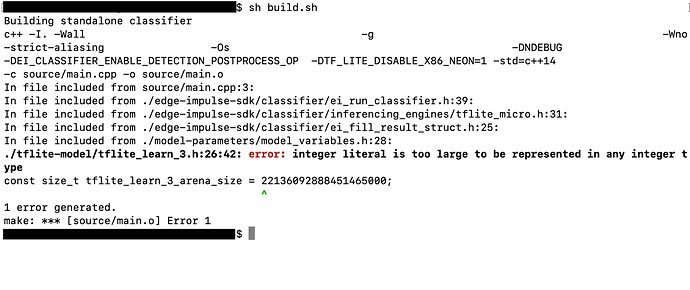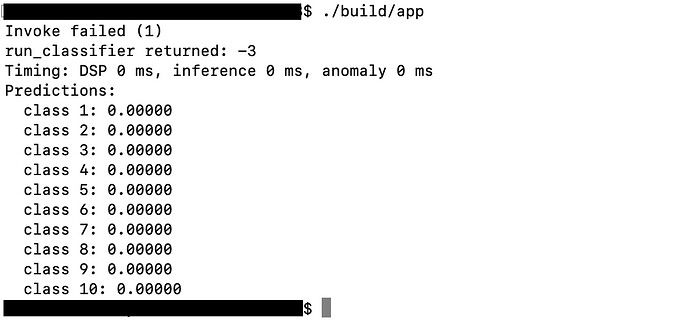Hi @Eoin,
I deleted the old project and created new one, but the issue remains. Here’s the screenshot of how the error appears:
Note that when I do the same (BYOM and deploy as a C++ library) with a smaller model (of size 90 KB), the error does not appear then and the standalone executable runs as expected.
Below are the codes in the main.cpp file, where I pasted my features in:
#include <stdio.h>
#include “edge-impulse-sdk/classifier/ei_run_classifier.h”
// Callback function declaration
static int get_signal_data(size_t offset, size_t length, float *out_ptr);
// Raw features copied from test sample
static const float features[] = {
0.1055, 0.1172, 0.1367, 0.2539, … (4096 features in total)
};
int main(int argc, char **argv) {
signal_t signal; // Wrapper for raw input buffer
ei_impulse_result_t result; // Used to store inference output
EI_IMPULSE_ERROR res; // Return code from inference
// Calculate the length of the buffer
size_t buf_len = sizeof(features) / sizeof(features[0]);
// Make sure that the length of the buffer matches expected input length
if (buf_len != EI_CLASSIFIER_DSP_INPUT_FRAME_SIZE) {
ei_printf("ERROR: The size of the input buffer is not correct.\r\n");
ei_printf("Expected %d items, but got %d\r\n",
EI_CLASSIFIER_DSP_INPUT_FRAME_SIZE,
(int)buf_len);
return 1;
}
// Assign callback function to fill buffer used for preprocessing/inference
signal.total_length = EI_CLASSIFIER_DSP_INPUT_FRAME_SIZE;
signal.get_data = &get_signal_data;
// Perform DSP pre-processing and inference
res = run_classifier(&signal, &result, false);
// Print return code and how long it took to perform inference
ei_printf("run_classifier returned: %d\r\n", res);
ei_printf("Timing: DSP %d ms, inference %d ms, anomaly %d ms\r\n",
result.timing.dsp,
result.timing.classification,
result.timing.anomaly);
// Print the prediction results (object detection)
#if EI_CLASSIFIER_OBJECT_DETECTION == 1
ei_printf(“Object detection bounding boxes:\r\n”);
for (uint32_t i = 0; i < result.bounding_boxes_count; i++) {
ei_impulse_result_bounding_box_t bb = result.bounding_boxes[i];
if (bb.value == 0) {
continue;
}
ei_printf(" %s (%f) [ x: %u, y: %u, width: %u, height: %u ]\r\n",
bb.label,
bb.value,
bb.x,
bb.y,
bb.width,
bb.height);
}
// Print the prediction results (classification)
#else
ei_printf(“Predictions:\r\n”);
for (uint16_t i = 0; i < EI_CLASSIFIER_LABEL_COUNT; i++) {
ei_printf(" %s: “, ei_classifier_inferencing_categories[i]);
ei_printf(”%.5f\r\n", result.classification[i].value);
}
#endif
// Print anomaly result (if it exists)
#if EI_CLASSIFIER_HAS_ANOMALY == 1
ei_printf(“Anomaly prediction: %.3f\r\n”, result.anomaly);
#endif
return 0;
}
// Callback: fill a section of the out_ptr buffer when requested
static int get_signal_data(size_t offset, size_t length, float *out_ptr) {
for (size_t i = 0; i < length; i++) {
out_ptr[i] = (features + offset)[i];
}
return EIDSP_OK;
}


